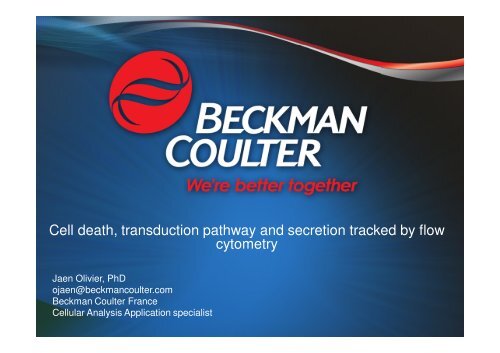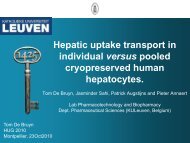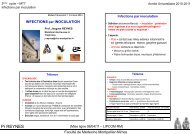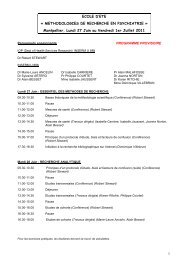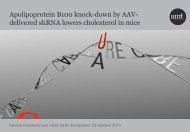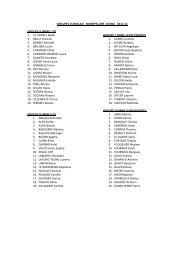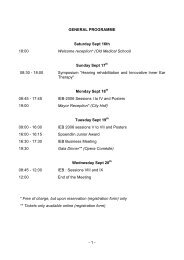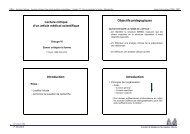Cell death, transduction pathway and secretion tracked by flow ...
Cell death, transduction pathway and secretion tracked by flow ...
Cell death, transduction pathway and secretion tracked by flow ...
You also want an ePaper? Increase the reach of your titles
YUMPU automatically turns print PDFs into web optimized ePapers that Google loves.
<strong>Cell</strong> <strong>death</strong>, <strong>transduction</strong> <strong>pathway</strong> <strong>and</strong> <strong>secretion</strong> <strong>tracked</strong> <strong>by</strong> <strong>flow</strong><br />
cytometry<br />
Jaen Olivier, PhD<br />
ojaen@beckmancoulter.com<br />
Beckman Coulter France<br />
<strong>Cell</strong>ular Analysis Application specialist
I.What is Flow Cytometry?<br />
• It is a cellular measure of several parameters<br />
• Based on <strong>flow</strong><br />
• Using electronic apparatus to measure<br />
http://www.unsolvedmysteries.oregonstate.edu/<strong>flow</strong>_06
I.Critical point<br />
• Hydrodynamic focusing : one <strong>by</strong> one<br />
http://probes.invitrogen.com/resources/education/tutorials/4Intro_Flow/player.html
I.Which parameters are measured?<br />
• Forward Scatter :<br />
FSC cell size<br />
• Side Scatter : SSC<br />
cell granularity<br />
• Fluorescences :<br />
probe linked to a<br />
cellular component<br />
http://probes.invitrogen.com/resources/education/tutorials/4Intro_Flow/player.html
I.Optical Bench<br />
• Collects light from<br />
sample<br />
• Separates light to<br />
have specific<br />
wavelenght<br />
http://probes.invitrogen.com/resources/education/tutorials/4Intro_Flow/player.html<br />
http://www.coulter<strong>flow</strong>.com/bci<strong>flow</strong>/instrumentsot.php
I.From light to data<br />
http://www.coulter<strong>flow</strong>.com/bci<strong>flow</strong>/
I.Data representation<br />
« Dot Plot »<br />
« Histogram Plot »<br />
Images were made with Kaluza Tm Software, BeckmanCoulter<br />
« Contour plot »<br />
« Contour plot with<br />
density »
I.Data representation : Radar Plot<br />
Multidimensional analysis<br />
Images were made with Kaluza Tm Software, BeckmanCoulter
I.Data representation<br />
Images were made with Kaluza Tm Software, BeckmanCoulter
II.<strong>Cell</strong> <strong>death</strong><br />
• Two principal ways of <strong>death</strong><br />
• Apoptosis <strong>and</strong> necrosis<br />
• Lot of modifications<br />
• Apoptosis : Chromatin condensation, DNA<br />
fragmentation, cell size decrease,<br />
granularity increase, reduction of<br />
metabolism, mithochondrial events,<br />
caspases activation, exposition of<br />
phosphatidylserine<br />
• Necrosis : <strong>Cell</strong> size increase due to loss<br />
of membrane integrity, <strong>and</strong> finally cell<br />
burst<br />
• Lot of ways to measure cell <strong>death</strong><br />
http://www.niaaa.nih.gov/Resources/GraphicsGallery/Liver/changes.htm
II.Basic <strong>death</strong> analysis<br />
• Membrane permability tests : PI, 7AAD,<br />
Sytox, Ethidium Bromide, YOPRO…<br />
Images were made with Kaluza Tm Software, Beckman Coulter
II.Basic <strong>death</strong> analysis<br />
• Retention tests : Calcein-AM, CFDA-<br />
AM, Vital Dye<br />
• Probe passively enters the cell, keeps in<br />
only in live cells<br />
http://www.currentprotocols.com/protocol/cy0404<br />
http://www.invitrogen.com
II.Apoptosis analysis<br />
• Annexin V FITC : phosphatidylserine<br />
• Propidium Iodide or 7-AAD : permeabilized<br />
membrane<br />
• Jurkat cells treated <strong>by</strong> Thapsigargin, SERCA pump<br />
inhibitor (Eckstein-Ludwig U <strong>and</strong> al, 2003, Nature 424 (6951): 957–61)<br />
Untreated<br />
Treated<br />
Data collected on <strong>Cell</strong> Lab QUANTA SC Tm , Beckman Coulter<br />
Images were made with Kaluza Tm Software, Beckman Coulter
II.Apoptosis analysis<br />
Untreated<br />
Treated<br />
Images were made with Kaluza Tm Software, Beckman Coulter
II.Apoptosis analysis<br />
• DNA fragmentation : Sub G1 peak analysis (Propidium Iodide or 7AAD)<br />
Hao LL et al Acta Pharmacol Sin 2004 Nov; 25 (11): 1509-1514
II.Apoptosis analysis<br />
• DNA fragmentation : TUNEL Assay (Terminal deoxynucleotidyl transferase dUTP<br />
Nick End Labeling)<br />
• BrdU is added to DNA break <strong>by</strong> TdT, anti-BrdU-FITC/PI<br />
• dUTP-FITC directly<br />
Martin <strong>and</strong> al, Current Protocols in molecular biology ;<br />
2001<br />
www.phoenix<strong>flow</strong>.com<br />
www.Compucyte.com
II.Apoptosis analysis<br />
• Mitochondrial events :<br />
APO2.7 protein detection<br />
Membrane depolarisation<br />
JC-1/DiOC(6)/Mitotracker...<br />
Bax/Bad/Bcl-2/Bcl-xL<br />
detection<br />
Caspase global or specific<br />
activity<br />
S Fulda <strong>and</strong> K-M Debatin Oncogene, 2006 : 25, 4798-4811
II.Apoptosis analysis<br />
• Membrane depolarisation<br />
JC-1 monomeric form<br />
: green<br />
JC-1 agregats : red<br />
Changing form is<br />
dependant of<br />
mitochondrial<br />
potential<br />
Mantena S.K <strong>and</strong> al, Mol Cancer Ther, 2006;5:296-308
II.Apoptosis analysis<br />
• Bax/Bcl-2 expression<br />
• Other protein<br />
expression,<br />
phosphoprotein<br />
Difficult but precise state<br />
of proteins that really act<br />
Images from <strong>Cell</strong> Signaling Technology/Beckman Coulter
II.Apoptosis analysis<br />
• Global or specific caspase activity : FLICA<br />
(FLuorescent Inhibitor of CAspase)<br />
Substrate reacts with all active caspases, covalently<br />
bound to caspase cystein<br />
VAD sequence specific, (DEVD 3,7; LETD 8)<br />
Reporter emits green light<br />
Non covalently bound molecules leave the cell<br />
Image from www.invitrogen.comc<br />
• Caspase 3 specific substrate : PhiPhiLux<br />
Arnoult D <strong>and</strong> al, <strong>Cell</strong> Death <strong>and</strong> Differentiation,<br />
2003;10:1240-1252<br />
www.PhiPhiLux.com
II.Apoptosis analysis<br />
• Active form of caspase 3<br />
Image from Beckman Coulter<br />
http://home.ncifcrf.gov/ccr/<strong>flow</strong>core/caspase3.htm
II.Apoptosis analysis<br />
• To resume :<br />
PS : Annexin V/7AAD or PI<br />
DNA fragmentation : Sub G1 peak/TUNEL<br />
Mitochondrial depolarisation : JC-1/DiOC(6)…<br />
Mitochondrial events : APO2.7/BcL-2/Bad…<br />
Caspase activity : FLICA/PhiPhilux<br />
Caspase active state : anti-cleaved caspase<br />
• Not only one, more you have more proofs<br />
you give…
III.Transduction <strong>pathway</strong> analysis<br />
• Apoptosis is a <strong>transduction</strong> <strong>pathway</strong><br />
• Phospho (S70) BcL-2 more informative<br />
than BcL-2 for sensoring apoptotic <strong>death</strong><br />
• A lot of <strong>transduction</strong> can be monitored <strong>by</strong><br />
<strong>flow</strong> cytometry<br />
• Why?<br />
• Monitoring of cell <strong>pathway</strong> more easily,<br />
<strong>and</strong> more quickly than Western Blotting<br />
• Agonist/antagonist studies<br />
• Pharmacological studies
III.Transduction <strong>pathway</strong> analysis<br />
• Analysis of phosphoprotein is<br />
not simple<br />
• Need optimisation,<br />
comparison, validation vs WB<br />
• Flow Cytometry is the only<br />
one to provide you<br />
informations on each cell<br />
Jacobberger <strong>and</strong> al, Cytometry,<br />
2003;54A:75-88<br />
Krutzik <strong>and</strong> al, Clin. Immunol,<br />
2004;110:206-21<br />
• Multiparametric analysis cell<br />
<strong>by</strong> cell<br />
• No need to culture, native<br />
sample<br />
• Technique is more easy <strong>and</strong><br />
faster<br />
• More stats
III.Transduction <strong>pathway</strong> analysis<br />
• Accessibility to the antigen?<br />
• Protein complex, fixator <strong>and</strong><br />
permeabilisator effect on sample?<br />
• Formaldehyde<br />
(1,5%) fixation<br />
<strong>and</strong> MeOH (90%)<br />
permeabilisation<br />
Krutzik <strong>and</strong> al, Clin. Immunol, 2004;110:206-21
III.Transduction <strong>pathway</strong> analysis<br />
• What i need? Best separation between neg <strong>and</strong> pos<br />
populations<br />
• Scatters? FSC <strong>and</strong> SSC?<br />
• Gating marker? Depends of your question…<br />
H 2 0<br />
2% For<br />
100% MeOH<br />
4% For<br />
0,1% Triton X-100<br />
4% For<br />
0,1% Triton X-100<br />
50% MeOH<br />
4% For<br />
0,1% Triton X-100<br />
50% EtOH Chow et col, Cytometry, 2005;67A:4-17
III.Transduction <strong>pathway</strong> analysis<br />
• Increasing fixation is not need<br />
• Samples <strong>and</strong> staining are stable<br />
• Fix Temp room or 37°C : same<br />
• Storage @ -20°C up to 5 weeks<br />
• Staining time : 15 min<br />
• Alexa Fluor 647 better, but depends of F/P ratio <strong>and</strong><br />
cytometer characterisitcs<br />
Krutzik <strong>and</strong> al, Clin. Immunol, 2004;110:206-21
III.Transduction <strong>pathway</strong> analysis<br />
• Differents methods For/Saponine, For/MeOH<br />
• Good, but not the best<br />
• For (2-4%)/Triton X-100 (0,1%) best for fresh blood samples : Best separation, good gating,<br />
scatters maintened<br />
Shankey et col, Cytometry, 2006;70B:259-69
III.Transduction <strong>pathway</strong> analysis<br />
• Monocytes Stimulated <strong>by</strong> LPS for different times<br />
• Stained with anti-CD14, fixed, permeabilized <strong>and</strong> stained for phospho<br />
ERK, SAP-JNK <strong>and</strong> p38<br />
Images were made with Kaluza Tm Software, Beckman Coulter
III.Transduction <strong>pathway</strong> analysis<br />
• Evaluation of cancer cells sensitivity to<br />
chemotherapy<br />
• Appreciate cytokines effects<br />
• Titration of an agonist<br />
Desplat <strong>and</strong> al, Cytometry, 2004;62A:35-45<br />
Krutzik <strong>and</strong> al, Cytometry, 2003;55A:61-70<br />
Krutzik <strong>and</strong> al, Clin. Immunol, 2004;110:206-21
III.Transduction <strong>pathway</strong> analysis<br />
• Immunology : Following activation of cells after stimulation with<br />
cytokines, GF, tetramers, vaccination trial<br />
• Hematology/pharmacology : Following activation status of cancer<br />
cells, pathological cells (auto-immune disease), treatment<br />
effectiveness<br />
• Discovery of signaling <strong>pathway</strong>s<br />
• Discovery of <strong>pathway</strong> blocking or activating molecules<br />
• Prognostic marker in disease<br />
• Limits :<br />
<br />
<br />
<br />
<br />
No localization informations unlike fluorescence microscopy<br />
Accessibility to the antigen depends of protocol<br />
Sensitivity is higher than WB, no enzyme amplification<br />
Quantity of data, need time to analyse<br />
Krutzik <strong>and</strong> al, Clin. Immunol, 2004;110:206-21
IV.Cytokine <strong>secretion</strong> analysis<br />
• Combine with results from ELISA in<br />
supernatant : bulk<br />
• Have a result cell <strong>by</strong> cell / type <strong>by</strong> type<br />
Images were made with Kaluza Tm Software
IV.Cytokine <strong>secretion</strong> analysis<br />
• How to do it?<br />
• Stimulate cells or not<br />
• Block <strong>secretion</strong> <strong>pathway</strong> : Brefeldin A…<br />
• Stain membrane marker(s)<br />
• Fix <strong>and</strong> permeabilise cells : For/MeOH<br />
or Triton X-100<br />
• Stain intracellular<br />
cytokine/phosphoprotein/intracellular<br />
protein<br />
• Acquire on <strong>flow</strong> cytometer
IV.Cytokine <strong>secretion</strong> analysis<br />
• Exemple : Effect of polluant on T cells?<br />
• Th17 cells are T cells CD3 + CD4 + IL17 +<br />
RORγt + CCR6 + Ouyang W <strong>and</strong> al, Eur J Immunol, 2009;39:634-675<br />
• Express the AHR Kimura <strong>and</strong> al, Proc Natl Acad Sci USA, 2008;28:9721-26
IV.Cytokine <strong>secretion</strong> analysis<br />
ELISA anti-IL17<br />
Kimura <strong>and</strong> al, Proc Natl Acad Sci USA, 2008;28:9721-26<br />
+ Dioxine + Carbazole
IV.Cytokine <strong>secretion</strong> analysis<br />
• How AhR works?<br />
Inhibition of pStat1<br />
Kimura <strong>and</strong> al, Proc Natl Acad Sci USA, 2008;28:9721-26
V.Conclusion<br />
• Flow cytometry is a powerfull analytical tool,<br />
polyvalent<br />
• <strong>Cell</strong> <strong>death</strong><br />
• Transduction <strong>pathway</strong><br />
• Secretions<br />
• All you want if you have liquid sample<br />
monodispersed elements, which emit light…


